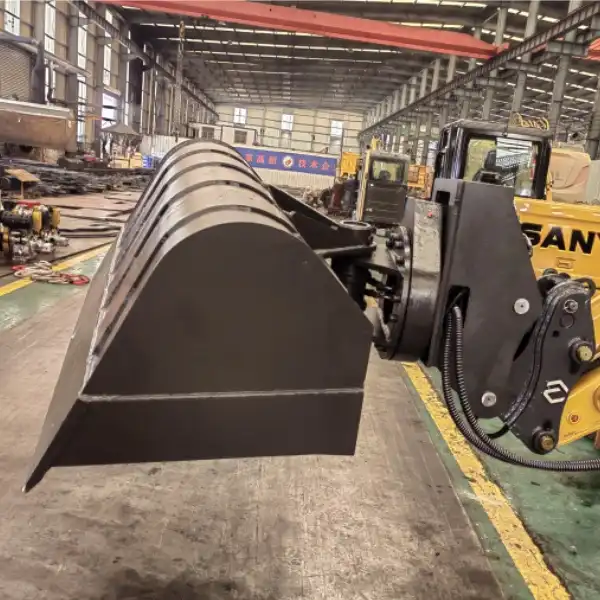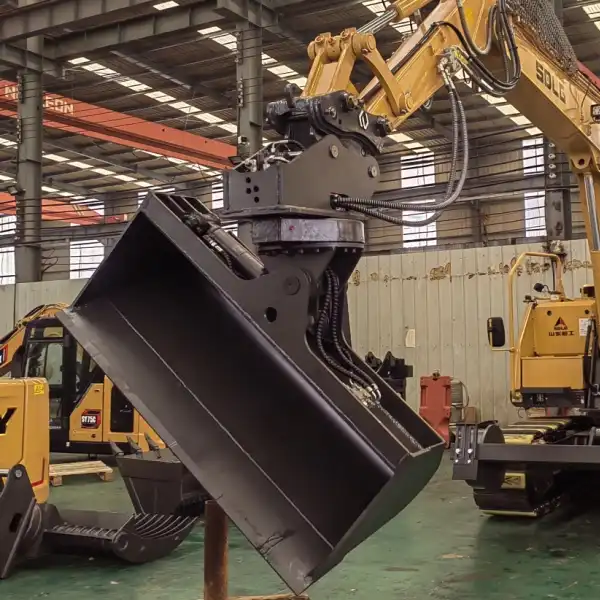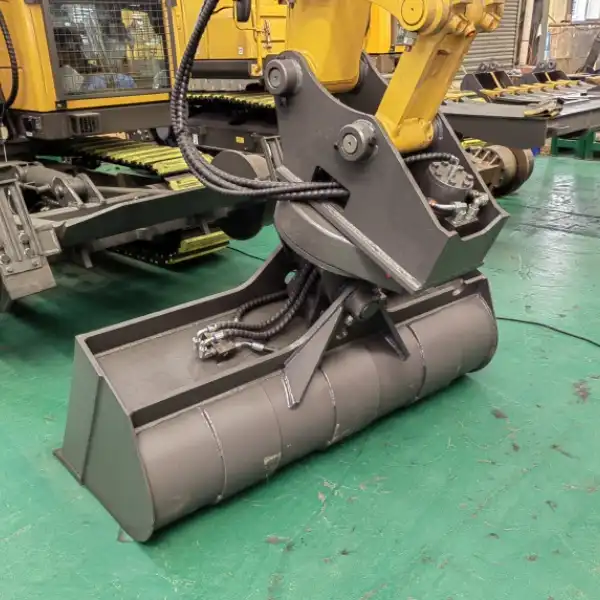How does the excavator swivel bucket work?
Ever wondered how excavator operators achieve such precise material handling in tight spaces? The secret lies in the ingenious design of swivel bucket technology. An excavator swivel bucket operates through a sophisticated hydraulic system that enables 360-degree rotation and multi-angle tilting capabilities, revolutionizing how construction and maintenance tasks are performed. The degree rotating hydraulic tilt ditching bucket represents the pinnacle of this technology, combining rotational freedom with precise angle control to tackle complex excavation challenges. This advanced attachment transforms a standard excavator into a versatile multi-directional tool, capable of reaching previously inaccessible areas while maintaining optimal bucket positioning. Whether you're working on railway maintenance, slope grading, or confined space excavation, understanding this mechanism opens up new possibilities for operational efficiency and precision in your projects.

Excavator's Hydraulic System: Powered Precision
The foundation of any swivel bucket operation lies within the excavator's hydraulic powerhouse. Modern excavators generate hydraulic pressure ranging from 3,000 to 5,000 PSI, creating the tremendous force needed to operate rotating attachments effectively. This pressurized hydraulic fluid travels through a network of high-strength hoses and control valves, delivering power precisely where it's needed most.
Hydraulic Fluid Circulation and Pressure Management
Hydraulic fluid circulation begins at the excavator's main pump, which draws fluid from the reservoir and pressurizes it for distribution throughout the system. The fluid flows through carefully engineered passages, maintaining consistent pressure while accommodating the varying demands of different attachment functions. Temperature regulation becomes crucial during extended operations, as hydraulic fluid performance degrades when overheated, potentially affecting the smooth operation of rotating components.
Advanced excavators incorporate pressure compensation systems that automatically adjust flow rates based on load requirements. When a degree rotating hydraulic tilt ditching bucket encounters resistance during rotation or tilting, sensors detect the increased pressure demand and redirect additional hydraulic flow to maintain consistent performance. This intelligent system prevents stalling and ensures smooth operation even under challenging conditions.
Power Distribution and Flow Control
The excavator's hydraulic system employs sophisticated flow control mechanisms to manage power distribution between primary functions and auxiliary attachments. Primary circuits handle boom, arm, and bucket movements, while auxiliary circuits provide dedicated power for specialized attachments like rotating buckets. This separation ensures that attachment operation doesn't compromise the excavator's primary functions.
Flow control valves regulate the speed and force applied to rotating mechanisms, allowing operators to achieve precise positioning during delicate operations. Variable displacement pumps automatically adjust output based on system demands, optimizing fuel efficiency while maintaining performance standards. When multiple functions operate simultaneously, load-sensing technology prioritizes power distribution to prevent system overload.
Safety Systems and Pressure Relief
Hydraulic systems incorporate multiple safety mechanisms to protect both equipment and operators. Pressure relief valves prevent system overpressure by redirecting excess fluid back to the reservoir when maximum operating pressure is exceeded. These safety features become particularly important when working with rotating attachments, as sudden stops or obstructions can create dangerous pressure spikes.
Anti-cavitation systems prevent air bubble formation within hydraulic lines, which could cause erratic movement or complete system failure. Filtration systems continuously clean hydraulic fluid, removing contaminants that could damage precision components within rotating mechanisms. Regular maintenance of these safety systems ensures reliable operation and extends equipment lifespan significantly.
Control Bucket: Mastering Rotation and Tilt Mechanisms
The control systems governing swivel bucket operation represent a perfect blend of mechanical engineering and electronic precision. Modern excavators utilize electrohydraulic controls that translate operator inputs into precise hydraulic commands, enabling smooth and accurate bucket positioning. These sophisticated control mechanisms allow operators to achieve previously impossible angles and orientations, dramatically expanding operational capabilities.
Joystick Command Translation
Operator commands begin with subtle joystick movements that electronic control units instantly translate into specific hydraulic actions. Advanced joysticks feature proportional control capabilities, meaning gentle movements produce slow, precise motion, while aggressive inputs generate rapid movement. This proportional response gives skilled operators incredible finesse when positioning rotating buckets in confined spaces or around sensitive infrastructure.
Modern control systems incorporate preset positioning features that allow operators to program commonly used bucket angles and rotational positions. These presets dramatically reduce cycle times during repetitive tasks, such as railway ballast placement or precise grading operations. Operators can switch between manual control and preset positions seamlessly, adapting to changing job site requirements without interrupting workflow.
Rotation Control and Angle Precision
The rotational mechanism within a swivel bucket relies on a precisely engineered rotary actuator that converts hydraulic pressure into rotational motion. These actuators feature internal gearing systems that provide both power multiplication and precise angle control. High-quality sealing systems prevent hydraulic fluid leakage while maintaining smooth rotation throughout the bucket's operational range.
Tilt control systems operate independently from rotational functions, allowing operators to adjust bucket angle while maintaining rotational position. This dual-axis control capability proves invaluable when working on slopes or creating precise grade transitions. The degree rotating hydraulic tilt ditching bucket exemplifies this technology, offering 45-degree tilt capability combined with 360-degree rotation for maximum versatility.

Well-Suited For Railway Maintenance Tasks
Railway maintenance operations demand specialized equipment capable of working within strict spatial constraints while maintaining exceptional precision. Swivel buckets excel in these challenging environments, offering capabilities that traditional fixed buckets simply cannot match. The unique requirements of railway infrastructure maintenance have driven significant innovations in rotating bucket technology.
Ballast Handling and Track Maintenance
Railway ballast handling requires precise material placement and removal without disturbing adjacent track structure. Swivel buckets allow operators to approach ballast piles from optimal angles, reducing the need for excavator repositioning and minimizing track disruption. The ability to rotate and tilt independently enables efficient ballast distribution along track sections while maintaining proper drainage gradients.
Track maintenance operations benefit enormously from the precision offered by rotating buckets. Operators can work parallel to railway lines while maintaining safe distances from live tracks, using the bucket's rotational capability to reach work areas that would otherwise require dangerous positioning. This enhanced safety profile makes swivel buckets increasingly popular among railway maintenance contractors.
Shoulder Formation and Drainage Management
Proper railway shoulder formation requires precise grading and material placement to ensure adequate drainage and structural support. Swivel buckets excel at creating consistent shoulder profiles, using their tilting capability to achieve exact slope angles specified in railway engineering standards. The degree rotating hydraulic tilt ditching bucket proves particularly effective for these applications, offering the angular precision needed for complex shoulder geometries.
Drainage management along railway corridors often involves working in confined spaces between tracks and adjacent infrastructure. Rotating buckets enable operators to excavate drainage channels and position culverts without compromising track stability or requiring extensive access preparation. This efficiency translates directly into reduced project costs and shorter track possession times.
Emergency Response and Rapid Deployment
Railway emergency response situations often require rapid deployment of specialized equipment capable of working in challenging conditions. Swivel buckets provide the versatility needed for various emergency scenarios, from derailment cleanup to washout repairs. Their ability to work at multiple angles from a single excavator position proves invaluable when time is critical and access is limited.
Emergency repair operations frequently involve working around energized systems and sensitive infrastructure where precision is paramount. The fine control offered by modern swivel buckets allows operators to perform delicate operations safely, minimizing risk to both personnel and equipment. This capability makes them essential tools for railway emergency response teams.

FAQ
What excavator sizes are compatible with swivel buckets?
Swivel buckets are available for excavators ranging from 7-ton compact units to 50-ton heavy-duty machines. The degree rotating hydraulic tilt ditching bucket typically suits 7-15 ton excavators, providing optimal balance between capability and maneuverability.
How much hydraulic flow do rotating buckets require?
Most swivel buckets require 15-30 GPM of hydraulic flow for rotation functions, with additional flow needed for tilting mechanisms. Excavators must have sufficient auxiliary hydraulic capacity to operate these attachments effectively.
What maintenance is required for swivel bucket systems?
Regular maintenance includes daily visual inspections, weekly lubrication of rotation points, monthly hydraulic fluid checks, and annual seal replacement. Proper maintenance ensures reliable operation and extends attachment lifespan significantly.
Can swivel buckets work in extreme weather conditions?
Quality swivel buckets operate reliably in temperatures ranging from -20°F to 120°F. Cold weather may require hydraulic fluid warming, while hot conditions demand enhanced cooling system monitoring.
How do rotating buckets improve operational efficiency?
Swivel buckets reduce excavator repositioning by up to 60%, decrease cycle times by 25-40%, and improve precision in confined spaces. These efficiency gains translate directly into reduced operational costs and increased productivity.
Understanding how excavator swivel buckets work reveals the sophisticated engineering behind these versatile attachments. From hydraulic power systems to precision control mechanisms, every component works together to deliver exceptional performance in demanding applications. Whether you're involved in railway maintenance, construction, or specialized excavation work, the degree rotating hydraulic tilt ditching bucket offers capabilities that can transform your operational efficiency. The technology continues evolving, with manufacturers like Tiannuo Machinery leading innovations that meet the changing demands of modern construction and maintenance operations. For detailed specifications and expert guidance on selecting the right swivel bucket for your applications, contact us at arm@stnd-machinery.com.
References
- Smith, J.A. and Thompson, R.K. "Hydraulic Systems in Modern Excavator Attachments: Engineering Principles and Applications." Journal of Construction Machinery Engineering, Vol. 45, No. 3, 2023.
- Chen, L.M. "Railway Maintenance Equipment Innovation: A Comprehensive Analysis of Rotating Bucket Technology." International Railway Maintenance Review, Issue 28, 2023.
- Rodriguez, M.C. and Williams, P.J. "Precision Control Systems for Excavator Attachments: Design and Implementation." Heavy Equipment Technology Quarterly, Spring 2024.
- Anderson, K.R. "Safety Systems in Hydraulic Construction Equipment: Modern Approaches to Risk Mitigation." Construction Safety Engineering Journal, Vol. 12, No. 2, 2024.
- Kumar, S.P. and Lee, H.J. "Efficiency Analysis of Multi-Directional Excavator Buckets in Infrastructure Maintenance Applications." Applied Construction Technology Review, No. 67, 2024.
About Author: Arm
Arm is a leading expert in the field of specialized construction and railway maintenance equipment, working at Tiannuo Company.

